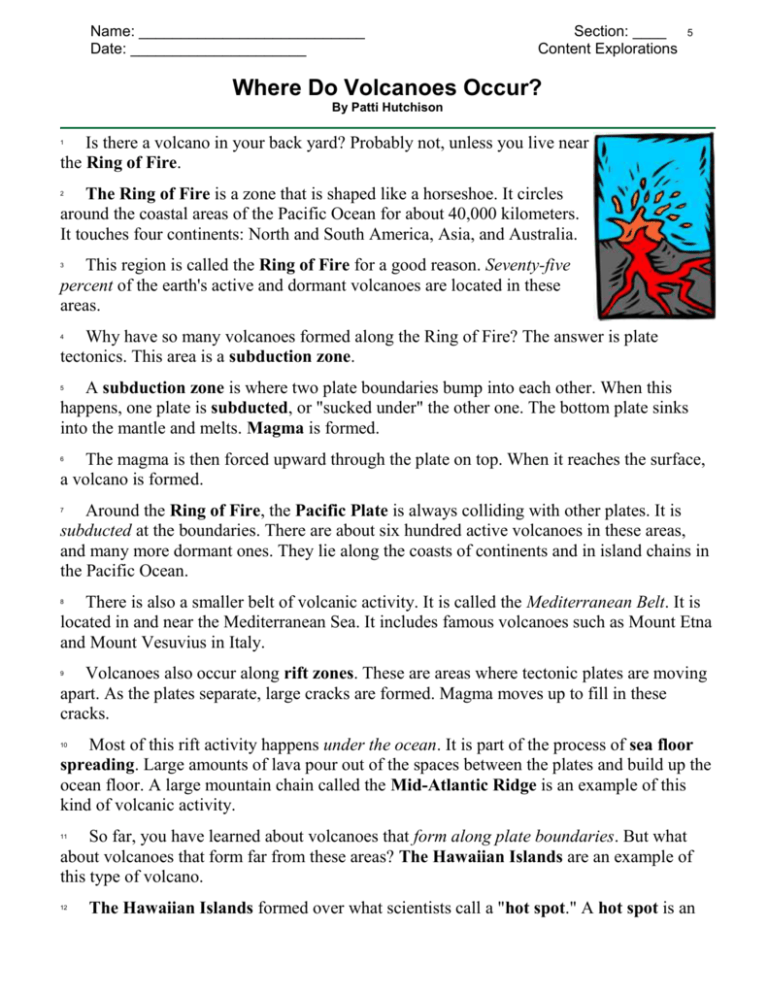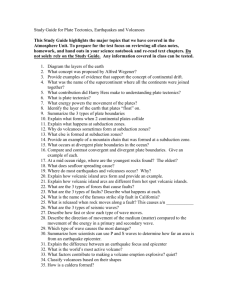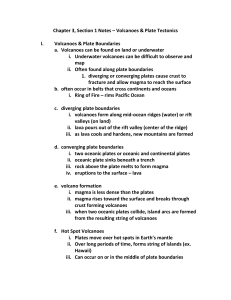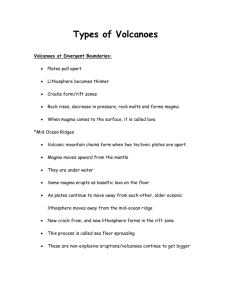Where Do Volcanoes Occur
advertisement

Name: ___________________________ Date: _____________________ Section: ____ Content Explorations 5 Where Do Volcanoes Occur? By Patti Hutchison Is there a volcano in your back yard? Probably not, unless you live near the Ring of Fire. 1 The Ring of Fire is a zone that is shaped like a horseshoe. It circles around the coastal areas of the Pacific Ocean for about 40,000 kilometers. It touches four continents: North and South America, Asia, and Australia. 2 This region is called the Ring of Fire for a good reason. Seventy-five percent of the earth's active and dormant volcanoes are located in these areas. 3 Why have so many volcanoes formed along the Ring of Fire? The answer is plate tectonics. This area is a subduction zone. 4 A subduction zone is where two plate boundaries bump into each other. When this happens, one plate is subducted, or "sucked under" the other one. The bottom plate sinks into the mantle and melts. Magma is formed. 5 The magma is then forced upward through the plate on top. When it reaches the surface, a volcano is formed. 6 Around the Ring of Fire, the Pacific Plate is always colliding with other plates. It is subducted at the boundaries. There are about six hundred active volcanoes in these areas, and many more dormant ones. They lie along the coasts of continents and in island chains in the Pacific Ocean. 7 There is also a smaller belt of volcanic activity. It is called the Mediterranean Belt. It is located in and near the Mediterranean Sea. It includes famous volcanoes such as Mount Etna and Mount Vesuvius in Italy. 8 Volcanoes also occur along rift zones. These are areas where tectonic plates are moving apart. As the plates separate, large cracks are formed. Magma moves up to fill in these cracks. 9 Most of this rift activity happens under the ocean. It is part of the process of sea floor spreading. Large amounts of lava pour out of the spaces between the plates and build up the ocean floor. A large mountain chain called the Mid-Atlantic Ridge is an example of this kind of volcanic activity. 10 So far, you have learned about volcanoes that form along plate boundaries. But what about volcanoes that form far from these areas? The Hawaiian Islands are an example of this type of volcano. 11 12 The Hawaiian Islands formed over what scientists call a "hot spot." A hot spot is an area of the mantle that has a very high temperature. Here, plumes of mantle material rise toward the earth's surface. The heat melts the rock and forms magma. The magma moves upward toward the surface. It breaks through the crust and forms a volcano. These islands continue to form above the ocean floor. This is a result of the Pacific Plate moving over a hot spot in the earth. Some volcanoes in these islands are dormant. This is because they no longer sit over the hot spot. 13 Some islands in this chain are still being created. Loihi is an active volcano that is forming east of the island of Hawaii. It may eventually rise above the ocean as a new island! 14 Volcanic eruptions do not occur just anywhere. Volcanoes are formed as earth's tectonic plates float around on the mantle. As the plates bump into each other, move away from each other, or pass over hot spots, volcanic activity is set into motion. 15 Copyright © 2008 edHelper Where Do Volcanoes Occur? 1. Where is the Ring of Fire located? 2. What percent of the earth's volcanoes lie along the Ring of Fire? Six hundred Forty thousand Seventy five 3. What is a subduction zone? What happens at a subduction zone? 5. An area of mantle that has a very high temperature is called a: Hot spot Rift zone Subduction zone 4. Areas where tectonic plates are moving apart are called: Coastal areas Rift zones Subduction zones 6. An example of volcanoes that have formed along a rift zone is: Ring of Fire Hawaiian Islands Mid-Atlantic Ridge





